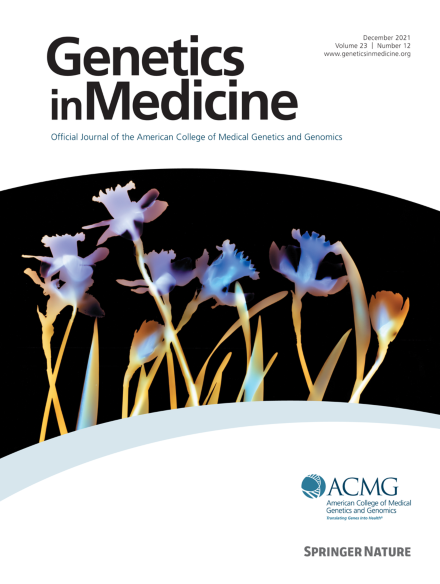Clinical and genetic delineation of autosomal recessive and dominant ACTL6B-related developmental brain disorders
IF 6.6
1区 医学
Q1 GENETICS & HEREDITY
引用次数: 0
Abstract
Purpose
This study aims to comprehensively delineate the phenotypic spectrum of ACTL6B-related disorders, previously associated with both autosomal recessive and autosomal dominant neurodevelopmental disorders. Molecularly, the role of the nucleolar protein ACTL6B in contributing to the disease has remained unclear.
Methods
We identified 105 affected individuals, including 39 previously reported cases, and systematically analyzed detailed clinical and genetic data for all individuals. Additionally, we conducted knockdown experiments in neuronal cells to investigate the role of ACTL6B in ribosome biogenesis.
Results
Biallelic variants in ACTL6B are associated with severe-to-profound global developmental delay/intellectual disability, infantile intractable seizures, absent speech, autistic features, dystonia, and increased lethality. De novo monoallelic variants result in moderate-to-severe global developmental delay/intellectual disability, absent speech, and autistic features, whereas seizures and dystonia were less frequently observed. Dysmorphic facial features and brain abnormalities, including hypoplastic corpus callosum, and parenchymal volume loss/atrophy, are common findings in both groups. We reveal that in the nucleolus, ACTL6B plays a crucial role in ribosome biogenesis, particularly in pre-rRNA processing.
Conclusion
This study provides a comprehensive characterization of the clinical spectrum of both autosomal recessive and dominant forms of ACTL6B-associated disorders. It offers a comparative analysis of their respective phenotypes provides a plausible molecular explanation and suggests their inclusion within the expanding category of “ribosomopathies.”

常染色体隐性和显性 ACTL6B 相关脑发育疾病的临床和遗传学划分。
目的本研究旨在全面描述 ACTL6B 相关疾病的表型谱,该疾病以前与常染色体隐性和常染色体显性神经发育障碍有关。在分子学上,核小体蛋白 ACTL6B 在该疾病中的作用仍不清楚。方法 我们确定了 105 例受影响的个体,其中包括 39 例先前报道的病例,并系统分析了所有个体的详细临床和遗传数据。此外,我们还在神经元细胞中进行了基因敲除实验,以研究 ACTL6B 在核糖体生物发生过程中的作用。结果ACTL6B 的单倍变异与严重至确诊的全球发育迟缓/智力障碍(GDD/ID)、婴儿期顽固性癫痫发作、失语、自闭症特征、肌张力障碍和致死率增高有关。新出现的单倍变异会导致中度至重度 GDD/ID、失语和自闭症特征,而癫痫发作和肌张力障碍则较少见。面部畸形和大脑异常,包括胼胝体发育不全、脑实质体积减小/萎缩,是两组患者的共同发现。我们发现,在核仁中,ACTL6B 在核糖体生物发生过程中,尤其是在前 RNA 处理过程中发挥着至关重要的作用。它对这两种疾病各自的表型进行了比较分析,提供了合理的分子解释,并建议将它们纳入不断扩大的 "核糖体病 "类别。
本文章由计算机程序翻译,如有差异,请以英文原文为准。
求助全文
约1分钟内获得全文
求助全文
来源期刊

Genetics in Medicine
医学-遗传学
CiteScore
15.20
自引率
6.80%
发文量
857
审稿时长
1.3 weeks
期刊介绍:
Genetics in Medicine (GIM) is the official journal of the American College of Medical Genetics and Genomics. The journal''s mission is to enhance the knowledge, understanding, and practice of medical genetics and genomics through publications in clinical and laboratory genetics and genomics, including ethical, legal, and social issues as well as public health.
GIM encourages research that combats racism, includes diverse populations and is written by authors from diverse and underrepresented backgrounds.
 求助内容:
求助内容: 应助结果提醒方式:
应助结果提醒方式:


